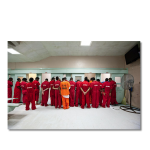Reporting Back: A Survey of Documentary Photography
by Shawn Daniell
As part of Cincinnati FotoFocus, ( a month long photographic program in Cincinnati and Northern Kentucky, consisting of over 75 exhibitions and over 500 photographers) Northern Kentucky University currently has Reporting Back: A Survey of Documentary Photography on display at NKU’s Fine Arts Center’s Main and Third Floor Galleries through October 26. This exhibit, consisting of fourteen photographers and 140 photographs, documents real world experiences through various points of view and photographic lenses. Photographers include Matthew Albritton, William Albert Allard, Dominic Chavez, Robert Dawson, Jim Dow, Ashley Gilbertson, Geoffery Hiller, Barbara Houghton, Samuel James, Richard Ross, Chris Smith, Bill Burke, Bob Hower and Ted Wathen.
Photography can capture a moment, a place, a time period and a feeling. What impressed me the most about this particular exhibit was the variety of imagery on display in one gallery space. The artwork in Reporting Back: A Survey of Documentary Photography, curated by Barry Andersen, Northern Kentucky University Professor Emeritus, tackles heavy subject matter, including world health issues, the war in Iraq, juvenile inmates in the United States, Ohio born presidents, the American West, the plight of women in India and much more.
For me, the images that made the biggest emotional impact were the photographs in Richard Ross’s Juvenile-in-Justice series, in which he photographed over 1000 inmates at over 100 facilities in 30 states across the United States. Ross, a photographer, researcher, and professor of art in Santa Barbara, California, has captured some truly heartbreaking images. In order to protect the identities of the photographed children, their faces are never shown. I think this only makes the imagery more powerful. These are the faceless children that make up the approximately 70,000 youth that are in detention centers daily in the United States.
Another intriguing collection in this exhibit is William Albert Allard’s Gone West series. Allard, a renowned National Geographic photographer, began his love affair with the American West in the 1960s and it continues to this day. In the Gone West series, Allard has shown me a way of life that I didn’t think really existed anymore. When I look at his photography, I feel as if I have crossed into another world. Allard’s images are full of vibrant lush colors, a sense of adventure, meditative glances and poignant moments caught on film.
In Bedrooms of the Fallen, photographer Ashley Gilbertson has photographed the bedrooms of deceased soldiers stationed in both Iraq and Afghanistan. These rooms have been left undisturbed; beds made, clothing put away in drawers, teddy bears lying on top of soft pillows, all waiting for their occupants to return home. The initial goal of this project is to photograph forty bedrooms. This ongoing project continues to commemorate those who lost their lives in the line of duty.
As I get older, I find that I am drawn to works that elicit feelings of nostalgia. With Tedd Wathen’s brainchild The Kentucky Documentary Photographic Project, I was able to feed this need for evidence of times gone by. This part of the exhibit included the images of photographers Bill Burke, Bob Hower, and Ted Wathen. The idea behind this project was to record life within the 120 counties of Kentucky, starting in 1975 and ending in 1977. Subject matter includes housing, family relations, rural Kentucky locations, and candid moments in the everyday lives of Kentuckians.
The photographers in Reporting Back: A Survey of Documentary Photography have given voice to various human scenes of beauty, tragedy, timelessness, nature and much more, one picture at a time. For more information about this exhibit, you can visit the website at HYPERLINK “http://www.nku.edu/~photo/reportingback/index.html” nku.edu/~photo/reportingback. Gallery hours are Monday through Friday from 9 a.m. until 9 p.m., and the exhibit closes on October 26th. Admission is free.
- Ashley Gilbertson “Bedrooms of the Fallen, Langenbrunner”
- William Albert Allard, “Buffalo in Snow”
- William Albert Allard, “Calf Branding”
- William Albert Allard, “Cow Camp at Dawn”
- Richard Ross, “Food Intake”
- Richard Ross, “Red Suits”









